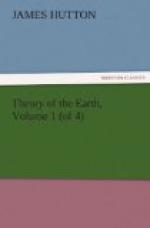The profusion of this vegetable matter, delivered into the ocean, which then generated land, is also evidenced in the amazing quantities of mineral coal which is to be found in perhaps every region of the earth.
Nothing can be more certain, than that all the coaly or bituminous strata have had their origin from the substance of vegetable bodies that grew upon the land. Those strata, tho’, in general, perfectly consolidated, often separate horizontally in certain places; and there we find the fibrous or vascular structure of the vegetable bodies. Consequently, there is no doubt of fossil coal being a substance of vegetable production, however animal substances also may have contributed in forming this collection of oleaginous or inflammable matter.
Having thus ascertained the state of a former earth, in which plants and animals had lived, as well as the gradual production of the present earth, composed from the materials of a former world, it must be evident, that here are two operations which are necessarily consecutive. The formation of the present earth necessarily involves the destruction of continents in the ancient world; and, by pursuing in our mind the natural operations of a former earth, we clearly see the origin of that land, by the fertility of which, we, and all the animated bodies of the sea, are fed. It is in like manner, that, contemplating the present operations of the globe, we may perceive the actual existence of those productive causes, which are now laying the foundation of land in the unfathomable regions of the sea, and which will, in time, give birth to future continents.
But though, in generalising the operations of nature, we have arrived at those great events, which, at first sight, may fill the mind with wonder and with doubt, we are not to suppose, that there is any violent exertion of power, such as is required in order to produce a great event in little time; in nature, we find no deficiency in respect of time, nor any limitation with regard to power. But time is not made to flow in vain; nor does there ever appear the exertion of superfluous power, or the manifestation of design, not calculated in wisdom to effect some general end.
The events now under consideration may be examined with a view to see this truth; for it may be inquired, Why destroy one continent in order to erect another? The answer is plain; Nature does not destroy a continent from having wearied of a subject which had given pleasure, or changed her purpose, whether for a better or a worse; neither does she erect a continent of land among the clouds, to show her power, or to amaze the vulgar man; Nature has contrived the productions of vegetable bodies, and the sustenance of animal life, to depend upon the gradual but sure destruction of a continent; that is to say, these two operations necessarily go hand in hand. But with such wisdom has nature ordered things in the economy of this world, that the destruction of one continent is not brought about without the renovation of the earth in the production of another; and the animal and vegetable bodies, for which the world above the surface of the sea is leveled with its bottom, are among the means employed in those operations, as well as the sustenance of those living beings is the proper end in view.




